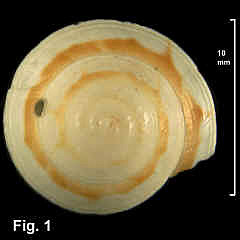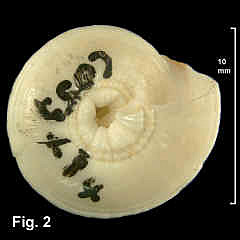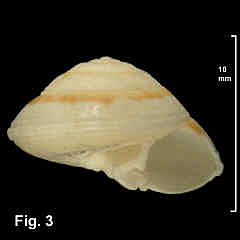|
|
ARCHITECTONICIDAE |
|
|
|
Psilaxis radiatus (Röding, 1798) Description: Shell fairly constant in height, spire convex in outline. Teleoconch whorls convex, smooth or with numerous, obsolete spiral threads and one or two stronger cords at bottom, forming moderate keel on periphery of last whorl. Base with obsolete spiral threads, folds radiating from umbilicus absent or obsolete; umbilicus open, about 14 % of base width, margin coarsely toothed, surrounded by a crenulate cord. Colour variable; background white or fawn; usually with tan band at top of whorls and often with axial spokes; peripheral ribs usually white; base fawn, umbilical margin white. Size: Up to 25 mm in diameter, commonly 15–20 mm. Distribution: Indo-West Pacific. In eastern Australia, as far south as Sydney. Habitat: Subtidal. Most museum specimens are from beach washup. Dredged as a fossil from Sydney Harbour. Rare in NSW. Comparison: The colour pattern of P. oxytropis and P. radiatus are both variable, and cannot be reliably used to differentiate the species. The most useful character is the width of the umbilicus: about 14% of base width in P. radiata and 25–30% of base width in P. oxytropis. Psilaxis radiata is quite rare in NSW, recorded only as far south as Sydney, while P. oxytropis is moderately common and reaches the Victorian border. Synonymy: Philippia stipator Iredale, 1931 is a previously recognised synonym. Figs. 1–3: Michaelmas Cay, Qld (C.053484). |
|


